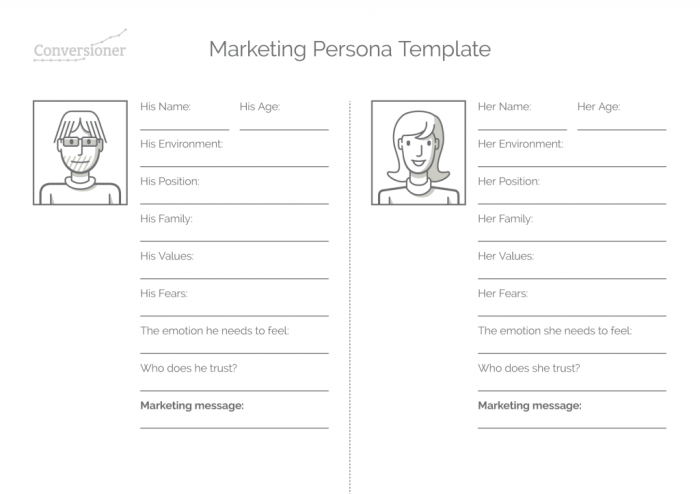Creating a Marketing Persona kicks off our journey into the realm of precision marketing, where understanding your audience is key to success. Get ready to dive deep into the world of consumer insights and strategic planning.
Understanding Marketing Persona: Creating A Marketing Persona

A marketing persona is a semi-fictional representation of your ideal customer based on market research and real data about your existing customers. It helps in creating targeted marketing strategies by identifying the specific needs, behaviors, and preferences of your target audience.
Significance of Marketing Persona
Creating a marketing persona is crucial for businesses to tailor their marketing efforts effectively. By understanding the demographics, psychographics, and buying behavior of their target audience, companies can develop personalized messages and offers that resonate with their customers, leading to higher engagement and conversion rates.
Examples of Successful Marketing Campaigns
- Apple’s “Get a Mac” Campaign: Apple used a marketing persona named “Mac” to represent a cool, young, and tech-savvy individual, contrasting it with a dull and boring character representing a PC. This campaign successfully highlighted the benefits of using a Mac computer over a PC.
- Dove’s “Real Beauty” Campaign: Dove created a marketing persona focused on promoting self-esteem and body positivity among women. This campaign resonated with its target audience by featuring real women of all shapes and sizes in their ads, challenging traditional beauty standards.
- Nike’s “Just Do It” Campaign: Nike’s marketing persona revolves around empowering athletes and individuals to push their limits and strive for greatness. By showcasing inspiring stories of athletes overcoming obstacles, Nike motivates its audience to pursue their goals with determination and passion.
Research and Data Collection
When it comes to creating accurate marketing personas, conducting research and collecting data are crucial steps in the process. By gathering insights from various sources, marketers can develop detailed profiles that represent their target audience effectively.
Customer Surveys, Interviews, and Analytics:
Customer surveys and interviews provide direct feedback from the target audience, allowing marketers to understand their needs, preferences, and behaviors. Analyzing this data helps in identifying patterns and trends that can be used to create more personalized personas. Additionally, website analytics and social media metrics offer valuable information on user interactions, helping marketers refine their personas based on real-time data.
Social Media Insights and Market Research:
Social media platforms are rich sources of information that can be used to gather insights about the target audience’s demographics, interests, and online behavior. By monitoring social media conversations and engagements, marketers can identify common pain points, interests, and preferences that shape their personas. Market research, on the other hand, provides a broader view of the industry landscape, competitor analysis, and market trends that can inform persona development.
Utilizing Customer Surveys and Interviews
Customer surveys and interviews play a critical role in gathering firsthand insights from the target audience. Here are some key points to consider when using these methods:
- Design surveys with specific questions that address key aspects of the target audience’s demographics, preferences, and challenges.
- Conduct interviews with a diverse group of customers to capture a range of perspectives and feedback.
- Analyze survey responses and interview transcripts to identify common themes and patterns that can inform persona creation.
Leveraging Social Media Insights for Persona Development
Social media platforms offer a wealth of data that can be utilized to enhance persona development. Here are some strategies for leveraging social media insights:
- Monitor conversations, comments, and engagements on social media to understand the target audience’s interests and behaviors.
- Use social listening tools to track s and hashtags related to your industry, products, or services to gather insights for persona creation.
- Analyze social media metrics such as engagement rates, follower demographics, and content performance to refine personas based on real-time data.
Identifying Demographics and Psychographics

When creating marketing personas, it is essential to consider both demographics and psychographics to truly understand and connect with your target audience.
Demographics
Demographics refer to the statistical data that describes a population, including factors such as age, gender, location, income level, education, and occupation. By analyzing these demographic factors, businesses can segment their target audience and tailor their marketing strategies accordingly.
- Age: Understanding the age range of your target audience can help determine their preferences, needs, and buying behaviors.
- Gender: Considering the gender of your audience can influence how you position your products or services in the market.
- Location: Geographic location can impact the way people perceive your brand and their access to your products or services.
- Income Level: Knowing the income level of your audience can help set pricing strategies and target the right market segment.
Psychographics, Creating a Marketing Persona
Psychographics delve deeper into the psychological and emotional characteristics of your target audience, including their values, interests, lifestyle, and behaviors. Understanding psychographic aspects can help create more personalized and impactful marketing messages.
- Values: Identifying the values that resonate with your audience can help in creating brand messaging that aligns with their beliefs.
- Interests: Knowing the hobbies and interests of your target market can guide the development of relevant content and product offerings.
- Lifestyle: Understanding the lifestyle choices of your audience can help in tailoring marketing campaigns that appeal to their daily routines.
- Behaviors: Analyzing the behaviors of your target audience can provide insights into their purchasing patterns and decision-making processes.
Creating Persona Profiles
Creating detailed persona profiles is crucial for any marketing strategy. By giving personas names, backgrounds, and personal stories, you make them relatable and easier to understand. Here are the steps involved in creating persona profiles and tips on ensuring they are realistic and data-driven.
Naming and Background
To start, give your persona a name that reflects their characteristics, such as “Tech-Savvy Tina” or “Outdoor Enthusiast Alex.” Then, provide a background story that includes details like age, job, hobbies, and goals. This helps humanize the persona and make them more relatable to your team.
Personal Stories
Create personal stories for your personas that Artikel their challenges, pain points, and motivations. For example, “Tech-Savvy Tina struggles with outdated technology at work but is passionate about staying up-to-date with the latest trends.” These stories provide context for your marketing strategy and help tailor your messaging accordingly.
Data-Driven Insights
Ensure your persona profiles are based on data-driven insights by conducting thorough research and analysis. Use surveys, interviews, and market research to gather information about your target audience’s behaviors, preferences, and needs. This data will help you create realistic persona profiles that accurately represent your ideal customers.